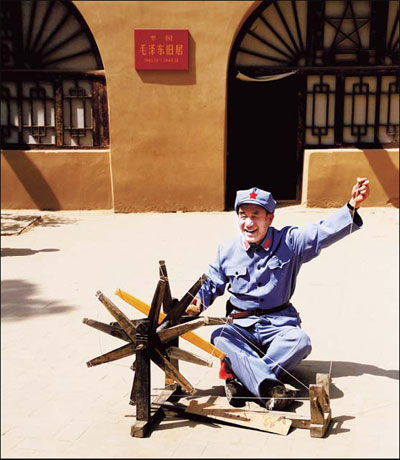

A tourist to Yan'an in Northwest China's Shaanxi province wearing a mock Red Army uniform poses as a weaver for a photograph on June 13. Liu Xiao / Xinhua
Editor's note: As the 90th anniversary of the founding of the Communist Party of China (CPC) is approaching, many Party members and ordinary people are planning or have made a trip to the CPC's revolutionary bases where the Party emerged and became strong. "Red tourism" is thriving across the vast land of China.
BEIJING - Yan Ruiming, a member of the Communist Party of China for seven years, said he recently made it to Yan'an in Northwest China's Shaanxi province, a renowned base of the Party before the founding of New China.
Traveling halfway across China by train last month on a week-long trip organized by his company, the 26-year-old Beijing resident and his colleagues visited historic cultural relics, watched documentary films on the evolution of the Party and sang "red songs".
Yan said they even led a simple life similar to life in those days, eating coarse grains and staying overnight in a yaodong - a typical dugout used as an abode - which provided shelter to Chairman Mao Zedong and his Party when US journalist and author of Red Star Over China, Edgar Snow, visited Yan'an.
"I have experienced and learned much about the hardship of the past and the plain living spirit of the army led by the Party, which is very inspiring," Yan told China Daily.
Thanks to the upcoming Party's 90th birthday, Yan and his colleagues, along with millions of other patriotic Chinese, are flocking as pilgrims to the far-flung "Red Capital" in order to revive old memories of the revolutionary years.
"Tour packages to red tourism spots have become increasingly popular this year," said Guo Yi, general manager of the domestic travel at the Beijing-based China Comfort Travel. "The whole market has been stimulated by the enthusiasm to commemorate the Party's birthday."
According to Guo, the number of the agency's "red tour" customers has increased by about 20 percent since March compared with the same period last year.
As well as visits to traditional sites such as Yan'an in Shaanxi province and the cradle of the Chinese revolution in Jinggang Mountain in Jiangxi province, the agency also designed more long-distance tours to Sichuan, Chongqing and Guizhou to meet customer demand to visit historical sites along the route of the Red Army's Long March.
"Many government organizations, companies and institutions initiated tours for employees to those sites for educational reasons, and this created a good atmosphere," Guo said.
China aims to expand its red tourism industry, which began during the 11th Five-Year Plan (2006-2010). In March, the central government issued a new outline for the development of red tourism over the next five years, which extended the time range of red tourism sites to the Opium Wars period in the 19th century.
The government listed 122 scenic spots as red tourism destinations, including cultural relics, scenic spots or museums that related to major events and figures in the country's revolutionary history.
In 2010, red tourism attracted 430 million tourists, accounting for 20 percent of all domestic tourists that year, according to Zhu Zhixin, director of the National Red Tourism Coordination Group. It is expected that the number of red tourism visitors will exceed 800 million in 2015, People's Daily reported.
"Cultural heritage tourism is not unique to China," Dai Bin, deputy head of the China Tourism Academy, told China Daily.
He said other countries also endorse sites, buildings and structures that are of great cultural value and are part of the nations' histories.
But in China, the revolution led by the Communist Party of China, the country's most important event in modern times, has dyed these destinations "red".
"With the government's support, infrastructure at these sites will be improved to attract more tourists," he said.
However, travel quality at the sites is still a concern for some industry insiders.
"In some patriotic and moral education centers free to the public, the guide services were relatively poor due to overpopulation," said Guo Yi.
But she said she believes the market will grow as more and more Chinese "do not want to forget the country's past".
